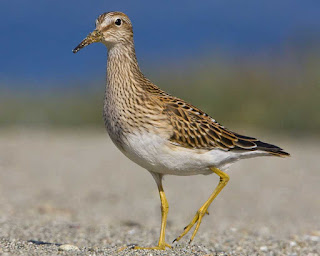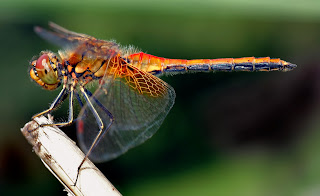Animals migrate for a lot of different reasons. Some travel long distances on a seasonal basis for food, finding their meal of choice hundreds and thousands of miles away. Others make their journeys to find mates while still others do it to avoid unfavorable weather, staying just ahead of the winter line as it creeps down from the poles every year.
The length of animal migrations vary as much as the reasons for doing it. Most migrations are measured in miles, though some animals like the golden jellyfish might travel just a few hundred meters on their daily migration, following the sun. Some kinds of plankton start their day hundreds of feet down the water column before coming up nearer the surface while the sun is out. At night they migrate back down to lower depths.
We wanted to focus on those species that undertake the really long migrations. Which are the most well-traveled animals in the world? Which organisms are traveling thousands, and even tens of thousands, of miles in pursuit of a better meal, warmer weather, or a chance to find a mate and reproduce?
We scoured the globe far and wide and bring you these nine animals with seriously long migrations.
Monarch butterfly
Of all the animals listed here, the monarch butterfly’s total migration is the shortest, at just a few thousand miles at most. But what they lack in overall distance, they more than make up by how they do it. See, the thing is, monarch butterflies only live for a couple of months. Their migration can take six months. This means that it takes two to three generations of butterflies for each migration! Somehow the knowledge of how to travel thousands of miles is embedded in their DNA and is finely attuned to allow them to pick up the path, no matter where they are born along it.
Monarch butterflies generally head south around August and north in the spring. Their Mexican wintering grounds were only discovered in the '70s and entomologists are still unsure about the biological mechanisms that allow for their multi-generational migration.
Whales
We decided to lump whales together into one large category because otherwise half the animals listed would be one kind of whale or another. Whales have the benefit of being massive and living in a medium — the wide open ocean — that is conducive to long-distance travel.
Humpback whale
Humpback whales are one of the largest animals in the world and can grow longer than 50 feet in length. Humpback whales were nearly driven to extinction by whaling, but a 1966 moratorium on hunting the species has helped their numbers recover. They are solitary animals and spend their summers eating in cold polar waters. In the winter, they migrate towards the equator to find a mate and breed. In all, your typical humpback whale can put in more than 6,000 miles of travel in a year.
Gray whale
Gray whales are another huge denizen of the deep and can grow to be nearly as large as the humpback. They too have proven to be attractive targets for whaling harpoons and their estimated population is just north of 20,000. Gray whales are recognized as having one of the longest migration routes for a mammal and can travel 10,000-12,000 miles in a year, spending the summer feeding in the waters between Alaska and Russia and mating and calving down around the Baja peninsula.
Southern right whale
The range of the Southern right whale extends from the coast of Antarctica to the southern most reaches of South America, Africa and Australia. They feed in the Southern Ocean in the summer and then migrate north, like the humpback and gray, to breed. There is still a lot we don’t know about the migratory grounds of the Southern right whale, but scientists have documented one way journeys of 2,750 miles (double it to get a round trip total of 5,500 miles).
Arctic tern
Birds are another type of animal well known for long migrations. Like whales, they live in a medium, the open sky, made for migrating. Birds take advantage of this by churning in some big miles. The Arctic tern, one of the longest migrators on the planet, can travel a mind boggling 44,000 miles in a year (Earth is just under 25,000 miles around). They do this by making a trip from their summer breeding grounds in the Arctic all the way to the Antarctic to winter, and back, every year. Multiply that by the roughly 30 years an average tern lives, and you can get more than 1 million miles in a lifetime. Too bad they don’t get frequent flyer miles for that.
Pectoral sandpiper
You wouldn’t think that the pectoral sandpiper would be a champion migrator just by looking at it — the small bird’s average wingspan is only around a foot and a half. But the pectoral sandpiper puts in some serious miles on the wing — more than 18,000 in a year. They travel annually from breeding grounds in the northern hemisphere (Alaska, Canada, and northern Asia) to the Southern Hemisphere (South America and Australia).
Sooty shearwater
The sooty shearwater is a large bird, with a wingspan more than three feet wide. They make their mammoth yearly migration of more than 40,000 miles by circling between the Northern and Southern Hemispheres. In 2005, scientists tagged 19 sooty shearwaters and watched in amazement as they flew huge distances in pursuit of warm weather and productive feeding grounds.
Globe skimmer dragonfly
The globe skimmer dragonfly is well named. One of the most widely distributed dragonfly in the world, they have been observed making journeys more than 2,300 miles and scientists think they could put in more than 11,000 miles of travel in a year. Not bad for an insect just a couple of inches in length.
Adelie penguins
Like all penguins, Adelie penguins spend their lives plying the waters of Antarctica. This curious little bird splits its year between breeding and feeding grounds that can require more than 10,000 miles of travel of transit. In 2003, penguin researchers tagged two colonies living on Antarctica’s Ross Island and found average birds migrating a little more than 8,000 miles with the longest route being nearly 11,000 miles.












































